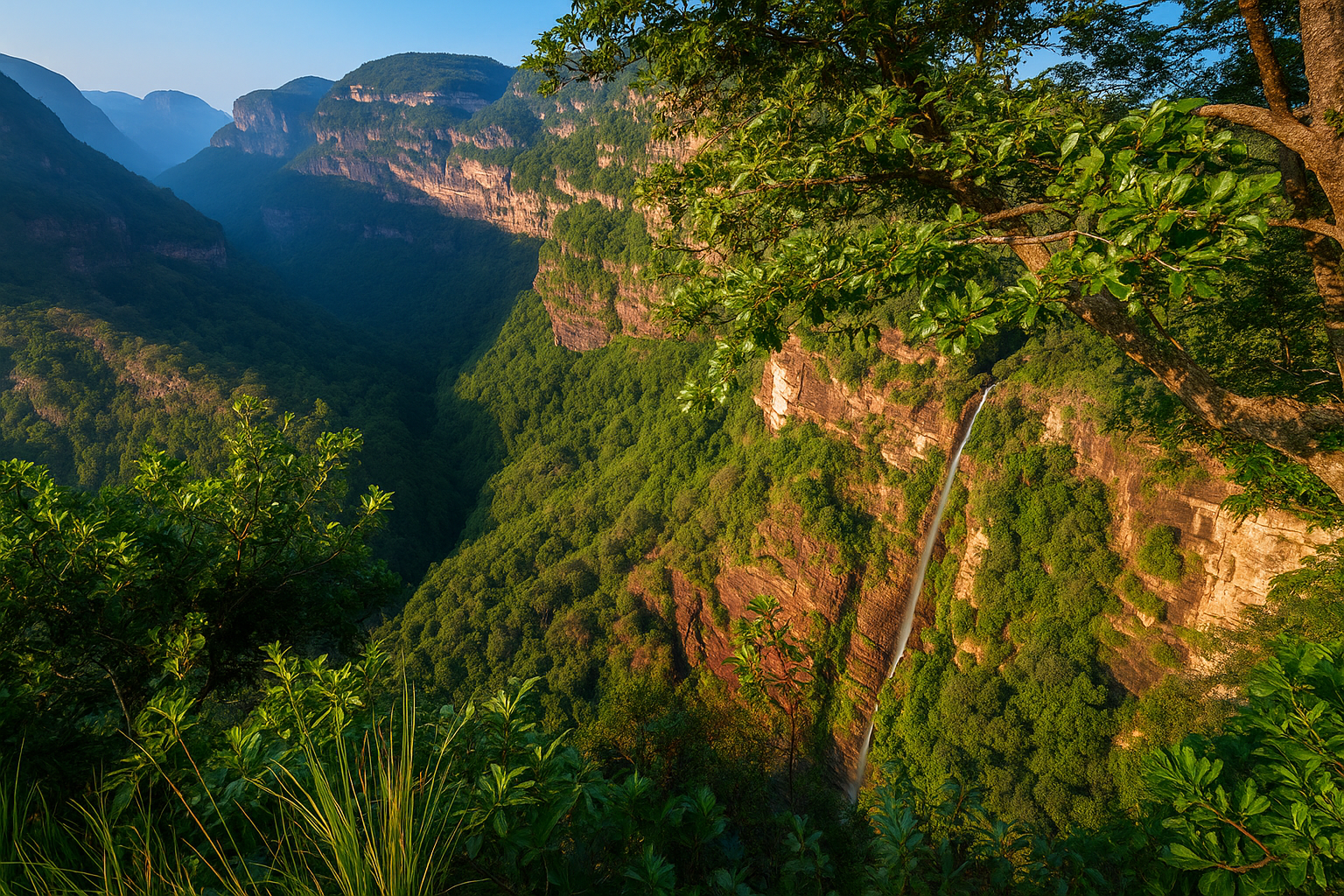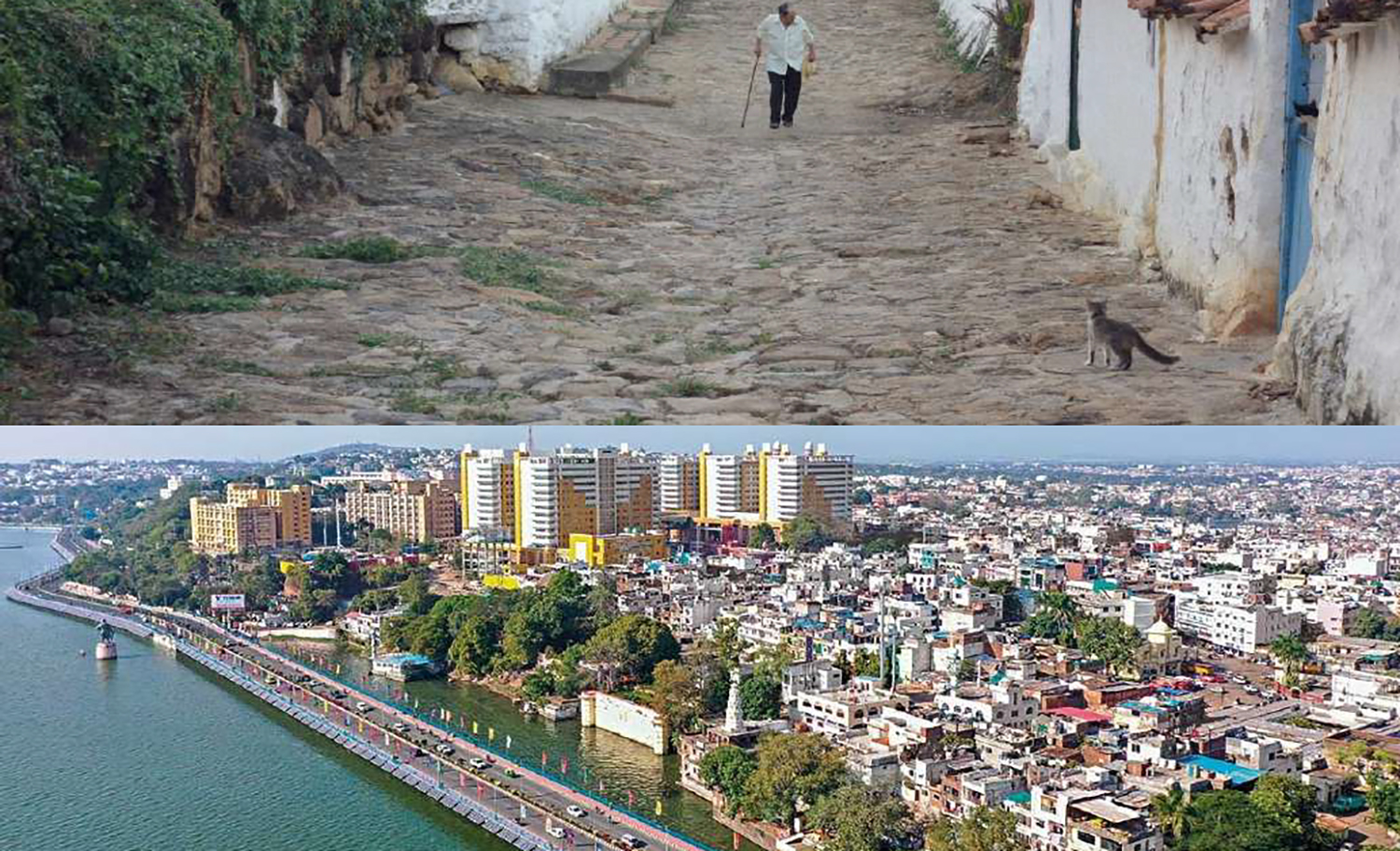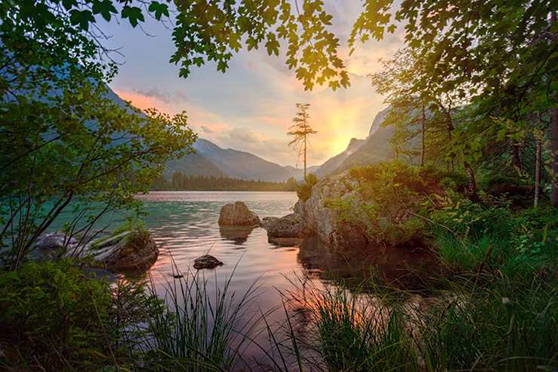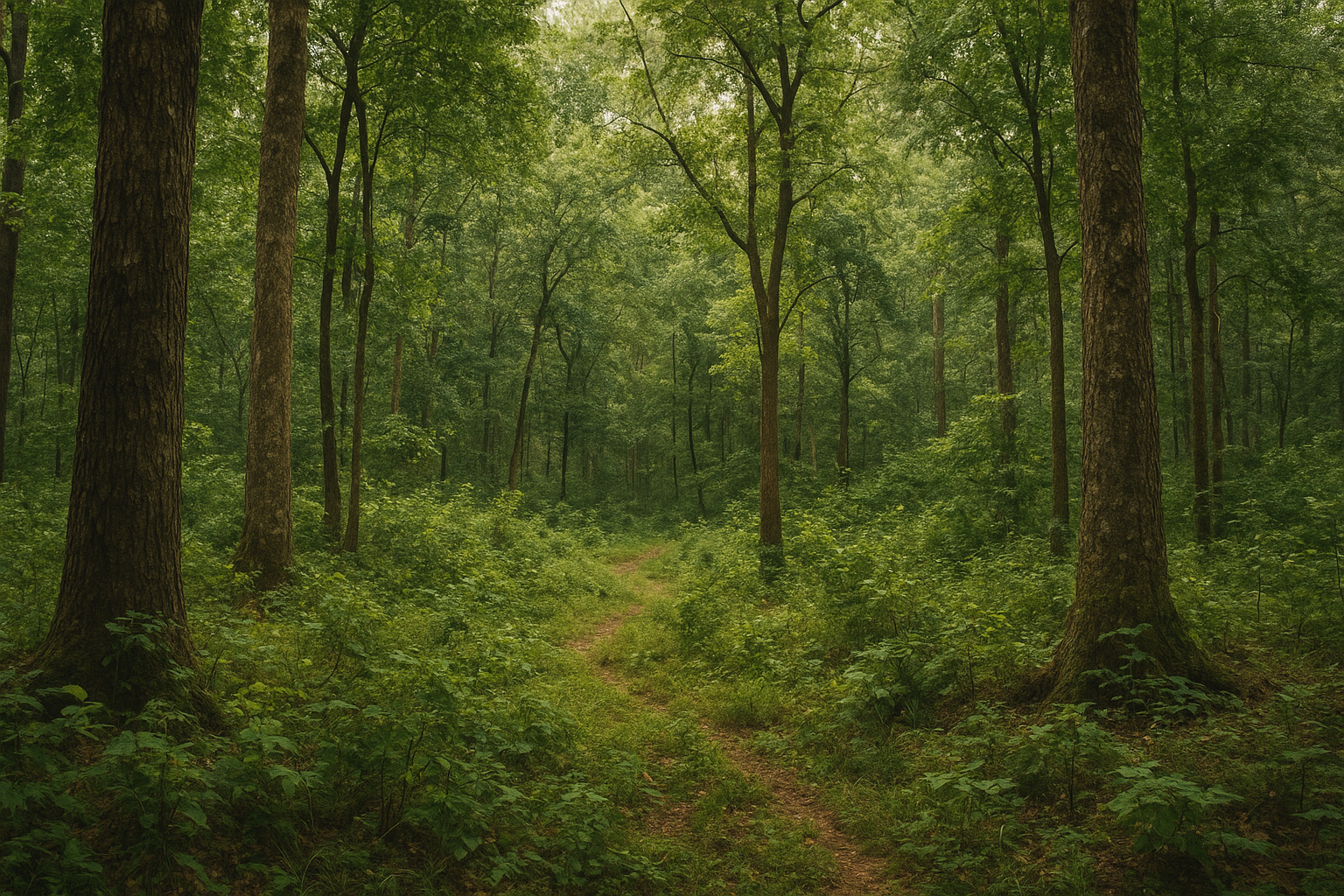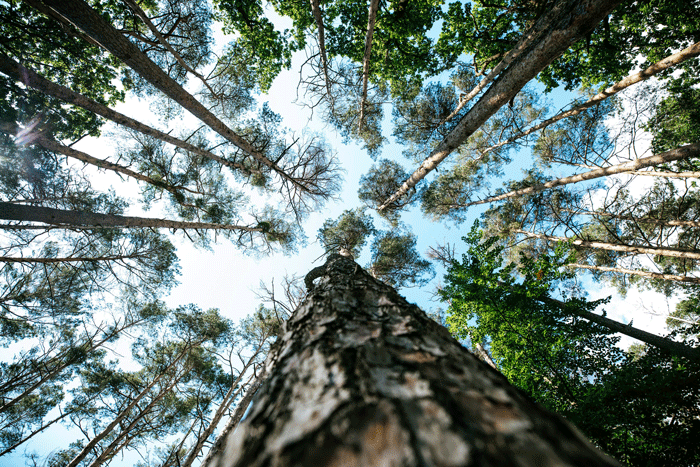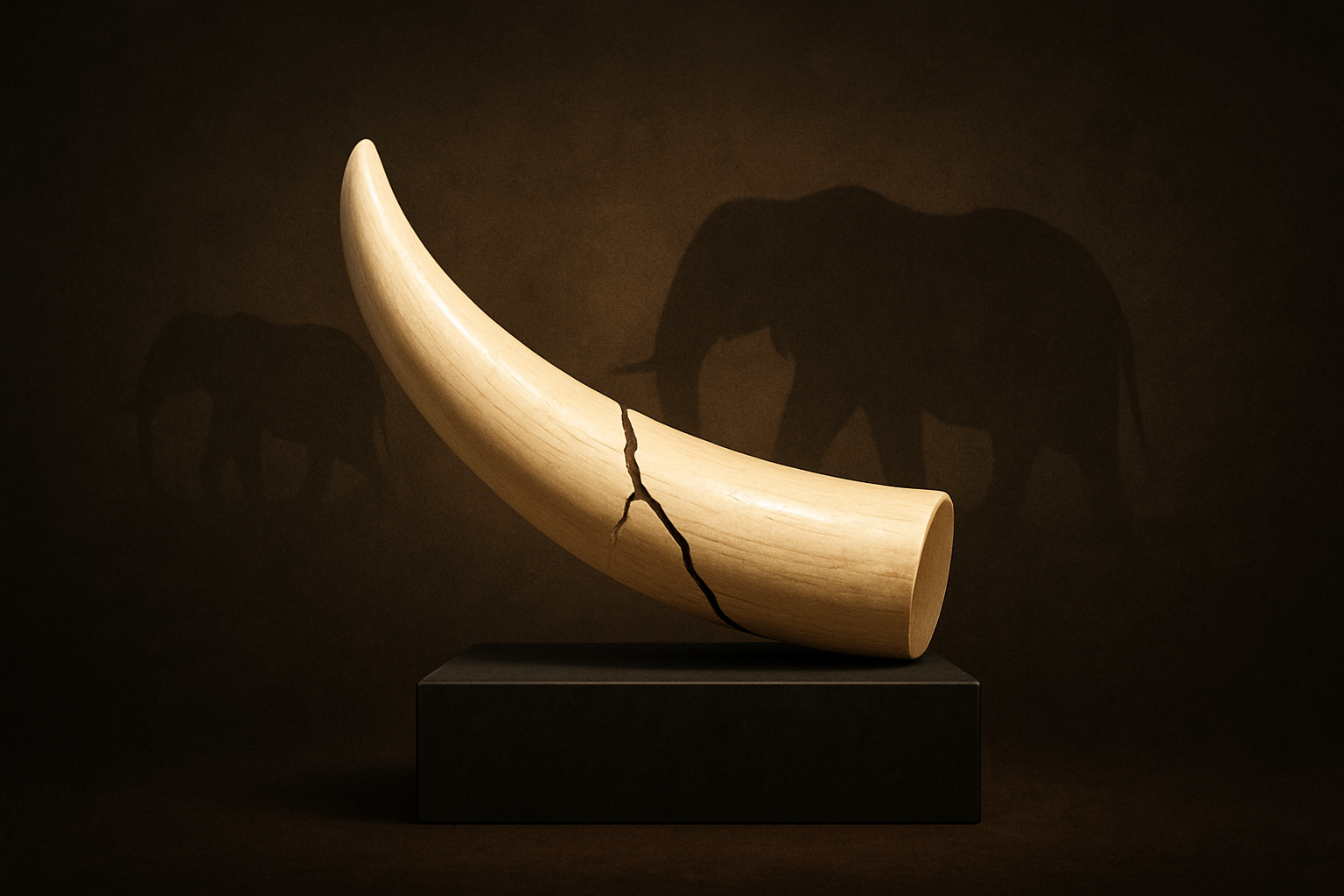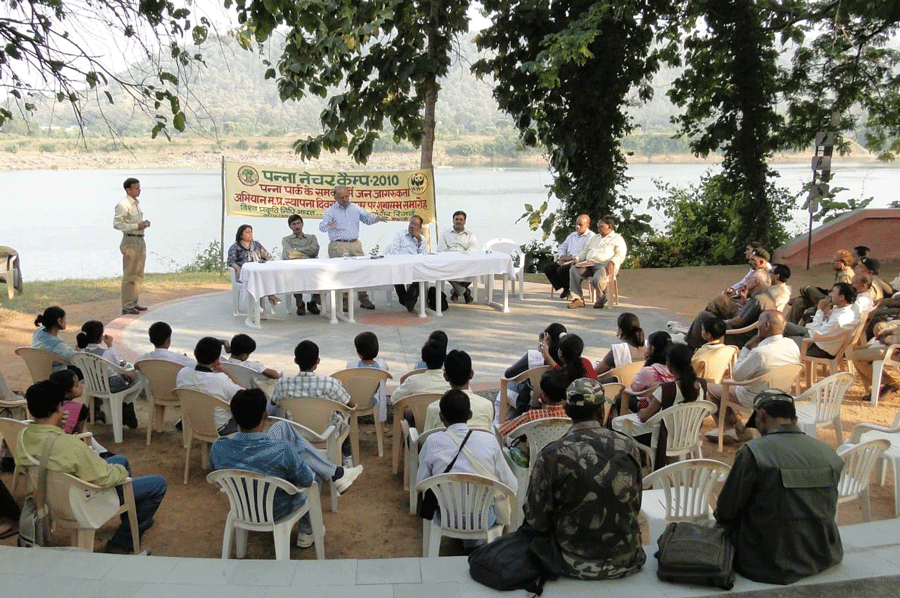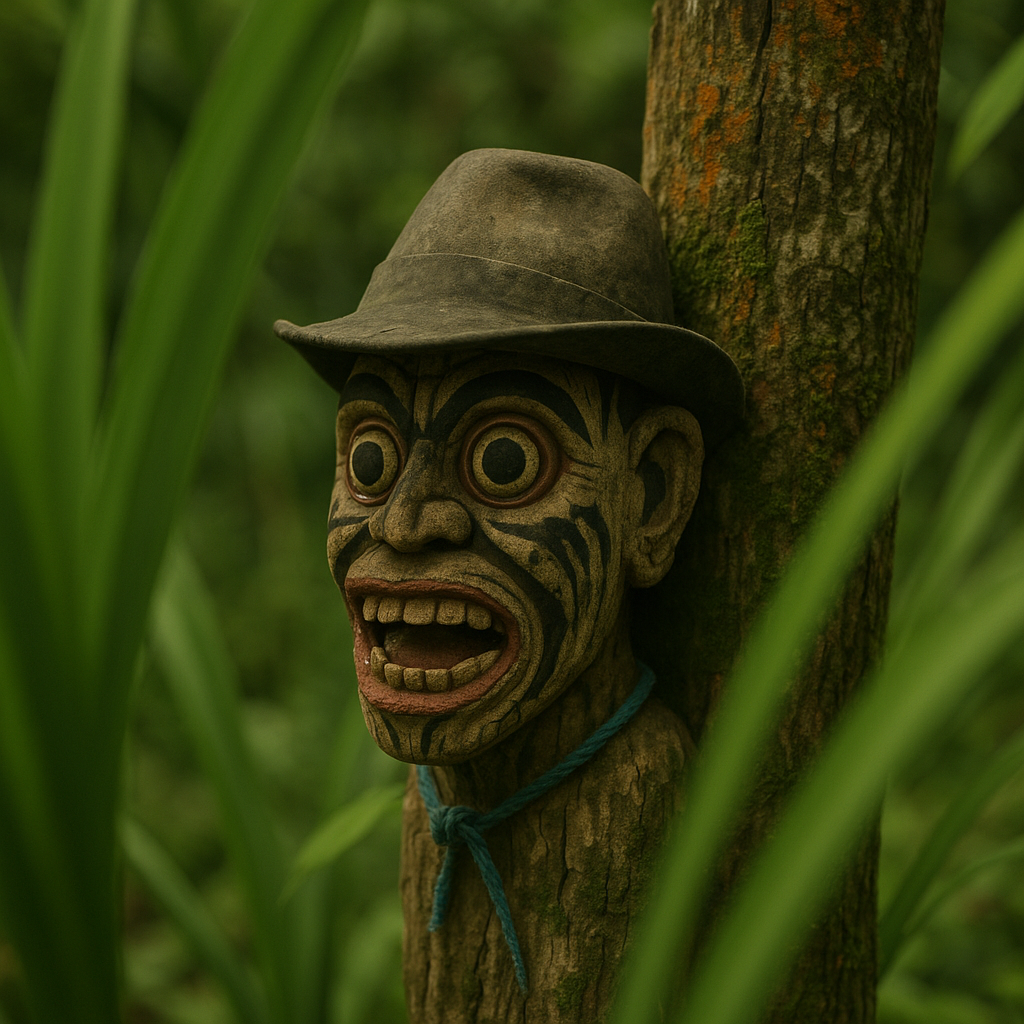LIFE OF A JUNGLEE
– J.J. Dutta
My first posting (April 1950) was in Yeotmal, now in Maharashtra under a DFO who was well known to be harsh on ‘direct recruits’. He had a liking for officers from the Ranger’s rank. The reasons I was to know much later. Anyway I had no trouble with him, only after six months a new DFO took over.
I had joined as Attached officer where two SDO Forests already existed and I was told that I will get good guidance from the SDOs, both of whom were from Ranger’s ranks with over 25 years of forestry experience. And I certainly got a good many anecdotes and stories from them but for solid ‘forestry’ guidance I had to fall back on myself.
This I did to my best abilities starting off to do ‘marking’ in high forest coupes. I spent continuous two and a half month in tents, camping inside the coupes which were teak forests with no water or leaf shade. But the local staff managed to keep me supplied with water from a village six km. away.
My DFO felt very happy about ‘this new ACF’ who preferred tent life to FRH’s but he hardly knew my reasons. I had borrowed my fathers 12 bore gun and got a license. Jungle fowl, green pigeons, ‘sawal’ fish in the river pools and ponds all held me charmed and I had the full run of the forests.
The CP + Berar shooting rules seemed to be all made for forest officers. As a gazetted officer of FD I was allowed to hunt anything ‘on duty’. The C.P..Game Act and Wild Animals and Birds Protection Act ‘did not apply’ to gazetted forest officers, something that no one would believe today. These were incorporated in the CP Forest Manual and as I learnt soon after, had a very potential reason.
Marking over, and the monsoons on my heels I was back to my headquarters to almost a standing ovation from my DFO! He looked at my sun burnt figure and seemed to be in a very good mood. Then he gave me a bundle of files and asked me to study them and make out briefs on each.
I had never seen office files before. It took me time to grasp the terminology and abbreviations, but I produced results, late I thought, but the DFO spoke to me only after two days and expressed that he could not himself have drafted anything better. My future from then on was smooth sailing.
The next DFO who came in after six months of my joining was interested in my hunting propensities and ordered me to share my meat hunts with him. This of course I was happy to do.
After an year as Attached officer, I was sent for ‘Range training’ to ‘Bhavargarh’ Range in Betul division, a teak and ‘mixed’ forest area, which was at that time also taken up for working plan revision by an officer six years my senior. Mr. N.K. Sharma WPO came to my Range with Silvi M.P. Mr. R.B. Mujumdar of his batch. We walked to the FRH from Shahpur, my headquarters to Kantawadi 14 kms. away, the luggage going on bullock carts. The officers refused to travel by cart and the 14 km. walk was easily done. The silvi disagreed with the WPO on the classification of a certain compartment as Teak’ forests (over 25% Teak) as apparently there were too many non-Teak trees in the area, but WPO said that if this was not Teak Forests’ then no area in Betul could be called Teak Forests. The plan was made. Teak was to be encouraged for better ‘revenue’ and non-teak areas were proposed to be planted.
This plan was followed by another plan with the same emphasis. Today Betul forests are almost ‘pure’ Teak. Mixed forests have virtually disappeared. The areas where sambar, cheetal, bison, tiger and leopard roamed around have become wildlife deserts. Betul, where the bungalows never needed ceiling fans even, now needed to be air conditioned, Betul, a favorite Division for British IFS officers, now is a poor division due to these environmental changes that I have seen and experienced in my lifetime. The current trend towards ‘environmental forestry’ does not help. The existing areas cannot be harvested to make way for enviro-friendly species.
An unusual event in Forest management took place in 1951. The Government of CP & Berar was starved for funds. One senior level forest officer suggested that ‘advance working’ of one coupe may be done all over the state! Govt took the bait and orders came, I had to work an additional main felling coupe in each FS. The revenue of my Range swelled from 21/a lakhs to 4 lakhs that year and the State Forest Revenue jumped from 21/2 crores to 4 crores. Government had enough money but the officer whose mischief had given this reprieve to Government was at the receiving end of abuse and ridicule from his fellow IPS officers. I am glad to say that this transgression of systematic forestry was subsequently regularized by partial stoppage of felling in about one fifth of ach division. Never again has this been heard of in Forestry anywhere in India.
In the third year I was packed off to ‘West Berar’ Division, comprising the two districts of Akola and Buldhana, both now in Maharashtra. Their forest area was very small and they were mostly poor quality Teak (QV) a type which did not exist in the Al Teak volume Tables. West Berar had a lot of ‘C’ class forests, mainly open grasslands but R.F. all the same. Many had good top soil hardly 30 cm deep which grew grass in good measure for village cattle. Many of these had been leased out for cultivation during World War II for ‘grow more food campaign’. I was assigned the job of renewing the leases on new guidelines issued by the Government to allot the plots to landless people with means to cultivate the land, whereas they had been in the part in the hands of rich landlords in the first instance. This I proceeded to do with total impartiality, to the consternation of the rich holders. I was promptly reported to the Commissioner and CM who had come on a tour to Buldhana. I was summoned and sheepishly I went into the presence of these august authorities not knowing what the complaint was. I was received with a friendly smile and was asked how exactly I was doing the renewal of the land plots. I replied that I had not deviated in any way from the guidelines, and wanted to know what was against me.
Then the bubble burst. The commissioner told me that I had not been complained against. The complaint was why the Revenue authorities who were not allotting ‘E’ class (non-RF) lands under the same GMF campaign in the way that I was doing. These august authorities did no more than see my face and I was told to go and resume my work. After finishing the work just ahead of the monsoons I returned to headquarters to be received by the DFO (a promoted officer) with open arms. He asked what ‘jadu’ I had performed that the Commissioner and CM were so happy about, and the Collectors were glum?
This was a part of my probationary learning. Another thing I learnt about the ‘grazing settlement’ in the working plans. This was a detailed exercise by a Dy. Collector (then called Extra Assistant Commissioner) around the villages of all reserved forests to ascertain how many cattle each village had sent to the RF in previous years of the new plan. Each village within 8 km. radius-was. thus allotted a cattle grazing quota and grazing licenses were issued accordingly. Check of grazing in forests was part of the duties of the ACF in the division, as well as of the SDOS and even the DFO took part in some areas. The regulation of grazing was’figid. Penalties and compounding were the order of the day and all regeneration areas whether natural or planted were closed to grazing, These abounded with quails, partridge, jungle fowl, peacocks, deer, pigs and neelgai. Tigers and Leopards were not too far nor few:
I trained my sights mostly on pigs and blue bulls both declared ‘crop pests’, and acquired skills that made me lose interest in shooting herbivore. My leanings shifted to carnivores.
I shot my first tiger in Buldhana district, leopard in Akola district apart from the ‘crop pests’. These were also cattle raiders.
My next posting was to Hoshangabad district as SDO Harda. Hoshangabad was a prize district for a forest officer as it held the world famed ‘Bori Teak’, I had been told by the DFO (the same Mr. N.K. Sharma whom I had met when RO Bhavargarh) that I would take over from him as DFO Hoshangabad, as he was going on long leave, and I had been hand picked for the division by Mr. G.G. Takle IFS then CCF MP. I was elated! Hoshangabad was always a ‘British’ division and I was the fifth Indian DFO. It included Pachmarhi hill station where all Britishers (including the Governor) used to congregate in summers, to avoid blistering heat of the plains.
Hoshangabad then was the largest division of the state in terms of revenue and area. I was asked to propose a division and I carved out Harda Division consisting of four ranges of Hoshangabad and two of Khandwa to form Harda division. On 16th March 1954 I took over as DFO Harda, and in the same year converted it into a fully departmental^ exploited division. Only bamboo coupes were still auctioned to contractors. Sometime later (in Feb 1955) Mr. GG Takle CCF and Mr. CE Hewetson Conservator Western Circle visited Timarni and Mr. Takle expressed surprise at the size of the Depot saying that he never knew that a depot selling Teak, and in this quantity existed in the state. In volume terms it was bigger than Ballarshah Depot of famous Chanda Teak (now in Maharashtra but in 1955 it was MP).
In Harda I had to face another test. The erstwhile Makrai state was a small enclave in the forests of Harda and had been absorbed by accession agreement with the Raja Saheb of Makrai. I was surprised to receive a letter from the Dy. Minister to CM, forwarding an application from the Raja of Makrai and two erstwhile forest contractors (now it was all departmental up to the depot) that they had an old agreement with Makrai state to obtain Raja’s timber and they should be allowed to operate that lease. The channel of sending the application was to me utterly strange, and I grew suspicious. The application and agreement both were typed in Hindi script, whereas the contract was said to be of 1949-50. Hindi fonts in typewriters had just been introduced by Remington and that gave me a clue. I obtained information on the date of release of the font from Remington Bombay, and it was much later than the date of the agreement. The stamp paper was purchased at a later date than the alleged date of agreement. To clinch the case I fished out rated passes of Teak issued by the Raja subsequent to the date of agreement, for sale of timber from the same area, to private persons. This could not have been done if the area had already been leased out as claimed in the application.
My report was acid and categorical. I even recommended that the Raja be prosecuted u/s 420 IPC and sent my report through the proper channel totally negating every claim and proving my case to the hilt. I did not then know that according to the merger agreements the Raja could not be prosecuted without special permission from the Government of India.
The report created some red faces, but I was marked as an officer of unbending ethics, and about a month after this at the Silvicultural Conference in D’Dun Mr Takle and Hewetson pointed me out to CCF Gujarat and told him the story of the Makrai case. Their looks at me were certainly appreciative.
Harda was now well set in departmental works and I was due for a change. (To this date Harda has never had contractors working.) I was thus transferred to Surguja Division.
This to everyone else seemed like a punishment posting, but I took it as part of my service. Young and energetic, lately married and just one baby still in arms I reached Ambikapur, on 1.1.1956, to a newly built DFO’s bungalow, and a very welcoming group of District Officers. Surguja was a truly wild place, and like all wild places, supremely secure! There were no pilfering, no thefts. The only crimes were murders, and in all cases the murderer just came to the PS and declared that he had murdered someone for very good reason. None of them was ever sent to the gallows. They served their terms in jail like the best of people, happy and hardworking, and the jail garden supplied us the freshest and choicest of vegetables at a nominal monthly payment. Otherwise Surguja had no vegetables! Only lately something used to come from Raigarh 200 kms away by road. But meat, fowl and eggs came unbelievably cheap, and the ‘Bishnubhog’ rice was really something for the Gods and at only Rs 13/- for 40 seers (37 kg.)!
I had intended early to call on the Maharaja but was told he stayed in Benares, and the same evening had a surprise visit from the heir-apparent Raja Saheb Ambikeshwar Saran Singh Deo, whose son, Madaneshwar S. Singh Deo was then under training in the IAS. Soon after the younger brother of Raja Saheb Shri. Chandikeshwar Saran Singh Deo, who used to live 40 km away in Pratappur also came to visit and I was overwhelmed by the affable way in which they took me as a new addition to their state.
The Maharaja Surguja, Maharaj Ramanuj Saran Singh Deo is well known to the world as the person who shot a record 1300 tigers in his lifetime, all in his own state (barring a few on a trip once to Nepal). Many people now look down on this as a monstrous deed leading to decimation of tigers, but I would very much differ. The fact is that Surguja of those days had no difficulty in supplying about 50 tigers per year. The forests, and the few cattle that the villagers possessed, provided rich and abundant prey for a large population of tigers and on my tours as DFO, then WPO and again DFO totaling nearly seven years I saw why Surguja was so hospitable to tigers. The forests were lovely Sal and mixed type and water was every where, to the extent that road making was a major problem due to innumerable water crossings. There was just one all weather road from Raigarh to Manendragarh through Ambikapur. All other roads were then either non-existent or just Kutcha road tracks, jeepable in fair weather.
The division was well provided. I had a jeep and a Land Rover, each with a trailer and one elephant for touring about. There was no plan of working the forests, and coupes were marked ad-hoc merely to keep the staff accustomed and trained in exploitation. The area had been worked for sleepers by Bengal Timber Trading in the days prior to merger of the State in 1951. They had removed all sleeper convertible trees and packed off. The remnant now needed management.
After a year and a half I was made working plan officer, Surguja. I took over and soon found that a de-novo first plan for over 5000 sq. km of forest, in the absence of even basic maps, was hardly possible. I requested for a split of North and South Surguja, and a separate WPO for South Surguja. This was accepted and I took charge of the first Working Plan of North Surguja Division.
In three and a half years I managed to complete the plan. The Division had been split and now two DFO’s and two WPO’s existed. Forestry was looking good. Plantations of Teak proposed early by the plans had started coming up. Rest Houses had been built, new roads more aligned and constructed and the revenues took a northward leap. From being a forlorn and forgotten division, Surguja became suddenly appealing.
Subsequent events, inadvertently, helped forestry in Surguja. One of the DFO’s spent a healthy 14 years in Surguja and was instrumental in faithfully complying with all the prescriptions of the plans. North Surguja was split again into two divisions for better management.
Some thirty years later, as PCCF MP I revisited Surguja. In one place I saw a lovely Teak plantation on the south face of a hillock and immediately on the north face was a lovely Sal forest! I was surprised. How could this Teak forest have been planted on such a lovely Sal area?
The DFO has done his homework. He promptly took out the Compartment History and there in my own hands was written that the north face was Sal forest while south face was mixed and should be planted with Teak, the soil etc being suitable. The compartment had been allotted by me to plantation working circle and a lovely 20 year old Teak plantation had come up.
The area has another memory for me. As WPO I had no vehicle so had to hitch a lift while my camp moved on 16 camels led by camel choudharys who came from Agra every year for 8 months @ Rs 70/- p.m. per camel plus one month’s wages for travel to and fro. One of these lifts was Rajpur (40 kms. From Ambikapur) with collector Mr. NN Chaturvedi, and SDO Mr. A Khan. On reaching Rajpur, and before dinner, the collector suggested that we move out to see some wildlife. He was senior person and not interested in hunting, but he thought it would be nice to see me shoot something. The fields were then sporting paddy crops and in one of them our spotlight showed a huge boar eating the paddy. Now here was indeed a fit case for action! I shot and the beast simply rolled over. Approaching the dead animal in the headlights of the jeep the collector remarked that I had surely shot a buffalo, the animal was huge. After my initial upset I went around the beast and there it was a boar alright but a size that nobody could have anticipated. Weighed in the scales at Rajpur it proved to be 5 mds 35 srs. in weight witnessed by the SDO and the Collector Surguja. The villagers of Rajpur were supremely happy that this raider had been eliminated, and of course they loved the meat. My camel choudharys melted the tallow from the boar and took away 4 canisters of 15 kg each, for use in Rajasthan in their household. These 16 camels, their choudharys and my own tent khallasis were always prompt in setting up my tented camps, with tents for each Rangers, Dy. Rangers and Foresters and surveyors, draughtsman, steno and peons/orderlies and occasional labor that need to stay in camp as their village was too far to reach after the days work. They also had a chance to get fresh wild meat from my hunts which held them back in spite of all odds. One night a camel got caught in a narrow but deep gully and a tiger circled around him apparently unable to fathom this new creature with the long neck that the tigers of Surguja had never seen!
After nearly seven years in Surguja, I opted for a change and requested the visiting CCF Mr. KN Mishra for posting as Silvi MP which post was going a-begging. I presently got the posting and shifted to Rewa – the then Forest headquarters of the state. In six month’s time I moved to Jabalpur and set up my office as Director State Forest Research Institute in rented accommodation. The search for a new location began and materialized, only to be lost to the Army Vehicle Factory of Jabalpur, the present site was then chosen as alternative and acquired, but my term as Silvi ended with promotion as CF working plans in June ’64. This was a short stint and in Dec. 641 was posted as CF Indore. This was considered a prize posting due to its headquarters but for me it was a low point. The circle hardly had any forests worth the name but was very well administered, and the office was a symbol of efficiency, The mannerisms of the staff all inherited from the State times (Indore and Dewas and many smaller states formed Indore circle) were new to me but I avoided feeling like a Maharaja, and stayed like a commoner. Then came a turning point in my career. I had a Master’s degree in Zoology and was picked up by GOI for training under the Colombo Plan for 6 months in Canada, in Wildlife Conservation and National Park Management. My family was allowed to draw my pay and could continue to live in the same bungalow. So on 3rd May 1966 I landed in Ottawa and reported to the Canadian Wildlife Service. This department was then in the stage of a split, the national parks being made into a separate department. The new director Dr. David Munroe was just the same age as myself and was as flustered in his new responsibilities as I was in a new land, and not knowing what I was to do next. The Canadian Wildlife Service Biologists did not know what I was there for and I was the single person under the scheme. I was asked how I would like to proceed and I gave them my idea of what would be good for me. The CWS then went into a huddle with the National Parks Service and by next day, in spite of all the turmoil of a split department I had my programme. I was provided full field dress, boots and equipment for the Canadian climate, it was still snowing in Ottawa in early May, as I had only enough civilian clothes, I was to learn my lessons, as and how I wished to. The Canadian Wildlife Service had opened its doors for me and I remember those six months in Canada as the best period of my life. I went across Canada from east to west and from US boundary in south to the Canadian Arctic (in two trips of about 3 weeks each).
Canadian species of wildlife were very different from ours but I found that the principles of management could easily be applied to our species. The parks management took me to 10 of their 19 National Parks and I studied the variations of policy according to needs of the area. One of the then most modern techniques of tranquilization by remote injection from a gun was being developed and tranquilizers of different types had been given to CWS by manufacturers for trials on wildlife. Cattle had been tranquilized by manual injection using hand syringes, but carnivores had never been so treated. A new line of action was being created.
Thus it was that I found my way to the Canadian Arctic, to tranquilize Polar Bears for biological studies on their health, growth rate and physiological parameters. Dr. Charles Jonkel was the CWS biologist on this project, and had done a lot of work on Black Bear in Montana USA for his doctoral thesis. Now he had embarked on the Polar Bear study, and I was his sole companion on this memorable venture.
We reached Fort Churchill, Ontario in September 1966 and were housed in the high security NASA complex. There was nothing else within 300 miles!
The Director of the space centre, Dr. Brandy met us and arranged for all the help that we could need. Our camp, in a wooden shack 8’X8′ at cape Churchill was 150 miles away on the Hudson Bay. We had a lot of field gear including an all terrain vehicle that could move on water mud and ice and tackle slopes of up to 30s all by itself. It had six balloon tires to help it float. A small two stroke engine below the seat, could take two people and their gear, but had no roof. It was almost a cross between a paddle boat and a motorcycle, but was immensely useful for Tundra, for which it had been designed. The Company-Bombardier had offered it free to us in exchange for feedback on its performance and shortcomings. I had a long time interest in motor vehicles and their mechanics and knew a lot about repairs etc. So Charles Jonkel was mighty pleased to have me as his mate.
We were dropped at Cape Churchill, by, NAS, A helicopter, a huge twin rotor machine that could take in about 20 people plus luggage, including a motor vehicle. We were given a two way radio and our reporting time to NASA was 8:00 pm every night. If no contact then the copter would come to look out for us.
I thought in the back of my mind that this was too much of arrangements but the next day on reaching the Cape Churchill, a chill ran down my spine. It was all white and permafrost and there was no human within 500 miles except NASA, and the Hudson Bay was in process of freezing. There were no land marks, the landscape was a maze of water ice and land and even the azimuth of the sun did not give any idea of direction. Compass readings were often confusing. How on earth could we come back to camp.
Jonkel was of course more knowledgeable about the conditions. The polar bears were leaving the freezing Bay and moving inland and in our outing in the ATV we spotted two, at long distances. Visibility was excellent in the crisp air and I had good eyesight. You could see for miles as the land was all flat and only sometimes undulating. Half was water covered.
We laid our traps of various kinds, gin taps, snares etc and baited them with canned salmon, which smelt strong and could attract the Bears from miles away. We captured 5 polar bears, tranquilized them and recorded data as needed and released them, following the protocol fixed for the job. Our was the first successful attempt at tranquilizing polar bear as five previous attempts had only resulted in deaths, creating a furor from the government.
I was provided a Cap-chur gun, syringes, ammo and tranquilizers of the latest types, for herbivores and carnivores, with their antidotes. I brought back 1.5 cubic meters of equipment, field gear and wildlife books and research literature which came by ship after my return home. On return from this wonderful trip, I was posted as Conservator Bilaspur circle, Development circle and then Bastar circle. Then I entered upon another phase of Forestry. I was on deputation to GOI for five years in the then Pre-Investment Survey of Forest Resources (PISFR) a FAO-UNDP project which had been launched in 1965.
This project identified potential forest areas to locate forest based industries and used very low intensity sampling over large areas to assess availability of resources. My predecessors had been trained in Sweden, and I too had a 12 week stay in Stockholm at the ‘Skogshoegskolan’ i.e. Swedish for ‘Forestry School’. On return I took up the work in Central Zone with hqs in Jagdalpur, but my work was in Andhra Pradesh.
The PISFR was well provided for its job. I even had at my disposal a Bell, Jet-Ranger jet helicopter for field work. The only other zone for the PISFR was North Zone, in UP-Himachal hill, where the helicopter had little use due to absence of landing spots. In my zone we had no such problem. The copter was used for grid surveys, dropping of survey crew at pre identified spots, and getting them back to camp at the end of the day. This needed absolute pin-point map reading and of course we had the best maps available. Our air crew was also very adept at map reading. I myself acquired this additional expertise and our job was successfully accomplished in given time. Some of the procedures I developed remained in vogue as long as PISFR continued with resource assessments. Then it branched out into wider fields and was re-christened Forest Survey of India, with headquarters at D’Dun.
On return from deputation in 19771 took charge as Chief Wildlife Warden, MP and was entrusted with setting up a whole new discipline in the Forest Department. Staff and finances, motor vehicles etc. were sanctioned but personnel for posts were hard to get. No one was too eager to join a new discipline and they did not know what was expected of them. They had no training of any kind in wildlife conservation. Fortunately the Indian Forest College had included Wildlife Conservation as a subject in the curriculum and a very competent MP Officer was in charge of the subject. We picked the best performers and soon a nucleus was formed, and of course others at all levels followed. Each one of them later became one of India’s top wildlife experts, trainers, and top officials of the discipline. I had made the right choices. New Sanctuaries and National Parks were notified with such rapidity thanks to the support from the Secretary Forests that soon MP topped in the matter of wildlife conservation. The MP model was supported by the GOI Ministry of Forests and held up as an example for other states to follow. Visits by GOI officials to some of our parks convinced them that here was a set-up that could deliver results and funds followed. After six years in the Wildlife side, it was my turn to move up.
Here again something happened that never happened before or after. My promotion orders came almost two months before the due date of my promotion. Again on nearing retirement I was given extension, two months ahead of the actual date of retirement. The reason and from the ministers own mouth was that everyone should know who the next boss will be and that he is not refinhg yet but extended.
The saddest part of my retirement was its circumstance. As I was sitting in my office, much earlier than regular office hours, preparing for handing over charge in the afternoon, I got the shocking news of the assassination of our beloved PM Shrimati Indira Gandhi. Only a few months before she had visited Kanha and went back supremely happy not only because she saw all the animals that Kanha had to offer, all in three noon hours, but because she saw no ever-present ‘security’ cordon anywhere around her. She was in an open ‘jeep’ with no armed escort anywhere. This had been a hard job for me to achieve, but Late Shri Arjun Singh, then CM ordered that if I wanted it that way it had to be that way. I sat dumbfounded on my office table and cancelled the farewell party that my office had arranged. Never again did I attend a farewell party.


